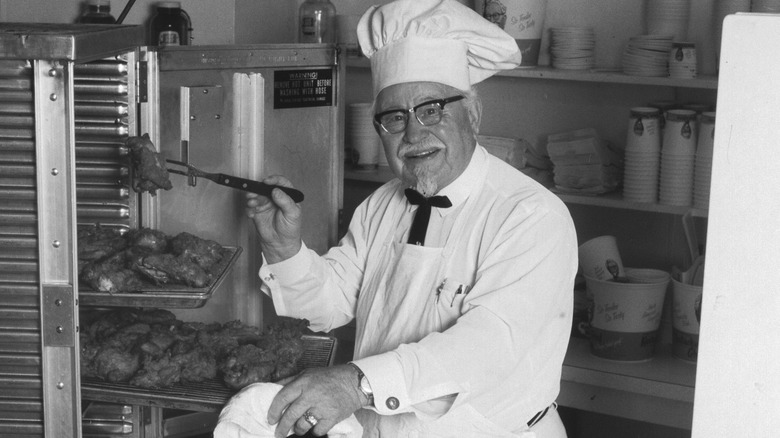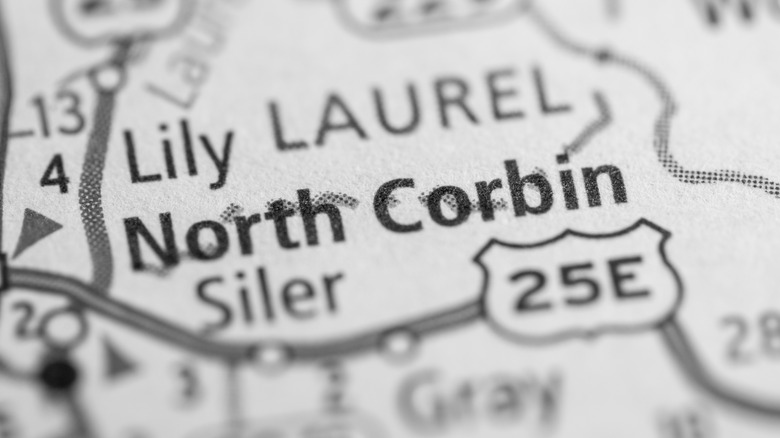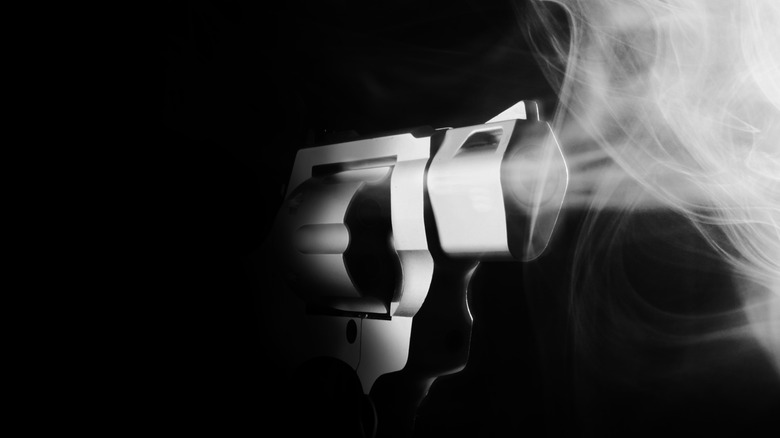The Time Colonel Sanders Shot Another Person
Few people in American history have a more iconic face than Colonel Harland Sanders, whose bearded visage graces every bucket of Kentucky Fried Chicken. The Colonel appears in most KFC advertisements, and in recent years he's been played by "Lord of the Rings" favorite Sean Astin and country music legend Reba McEntire, among others. With so many fictional depictions out there, it's easy to think of the Colonel as a mere marketing creation, but long before Astin and McEntire, it was Sanders himself who appeared in KFC commercials, doing so all the way up to his death in 1980 at age 90 (via Britannica). Yes, Harland Sanders was indeed a real man, but he was not, strictly speaking, a real colonel.
According to The Vintage News, the title of Colonel was given to Sanders by former Kentucky governor Ruby Laffoon "in recognition of his contributions to the state's cuisine." A Kentucky Colonel is the state's highest civilian honor. Walt Disney, Muhammad Ali, and Josh Hutcherson are just a few of the others who've earned the title. However, Sanders did spend three months in the United States Army back in 1906, even falsifying his birthdate to enlist. It was one of many careers he would take on in his life. Per History, Sanders also operated a ferry, sold life insurance, and delivered babies before opening his first restaurant inside a gas station. It was there that he'd enter a business rivalry so fierce that it ultimately ended in a hail of bullets.
Welcome to Hell's Half-Acre
The roots of KFC can be traced to a Shell gas station in Corbin, Kentucky that Sanders took over in 1930. According to Food & Wine, Harland Sanders cooked sumptuous Sunday dinners for his family, and soon realized he could make an extra buck by selling fried chicken. It was the start of a long saga that would eventually see the Colonel sell his secret recipe to franchises across the nation. But back in the 1930s, Sanders had a big issue in his small town. In a book entitled The Colonel: The Captivating Biography of the Dynamic Founder of a Fast-Food Empire, author John Ed Pearce notes that North Corbin, the neighborhood where Sanders had his Shell station, was so infamous for its rampant gun violence that it was nicknamed "Hell's Half-Acre."
Fortunately, the locals got most of their kicks shooting inanimate objects, especially billboards. A particularly popular feat of marksmanship involved dotting the i's on signs with bullet holes. This was a major problem for Sanders because every time he put up a billboard, some hooligan would pump it full of lead. Sanders got around this by painting a sign on the concrete wall. All it said was, "North to Lexington." There was no mention of Sanders' business, but it helped him anyway by diverting traffic away from a rival Standard Oil station. That station's owner, Matt Stewart, did not take kindly to the gesture, and this sparked a vicious rivalry between him and Sanders that would escalate to a deadly degree.
Shots fired
Matt Stewart struck back by painting over Harland Sanders' sign, a move that Sanders quickly countered by repainting. According to The Colonel: The Captivating Biography of the Dynamic Founder of a Fast-Food Empire, Sanders then visited Matt Stewart to talk things out. Accounts of the conversation differ, but it ended with one or both of the men making violent threats. Their bad blood boiled over on May 7, 1931, when a local boy ran by the Shell station and told Sanders that Matt Stewart was painting over his sign again. At the time, Sanders was visiting with Robert Gibson and H.D. Shelburne, both employees of the Shell corporation. Upon hearing the news, all three men piled into a car and drove down to confront their rival. They caught Stewart in the act, and Sanders shouted, "Well, you yellow dog, I see you done it again," though he probably used more explicit language.
Nobody can agree on who pulled their gun first, but Gibson was killed after being shot multiple times. Sanders returned fire, striking Stewart in the shoulder. Shelburne put another bullet in Stewart's hip, ending the melee. Stewart got an 18-year prison sentence for murder, but charges against Sanders and Shelburne were dropped. The Colonel's reputation never suffered; the local newspaper misprinted his name as "H.D. Saunders." In a fascinating twist, Mental Floss reveals that Stewart's daughter, Ona May, married the brother of Sanders' second wife, and ended up working for the business her father nearly died over.


